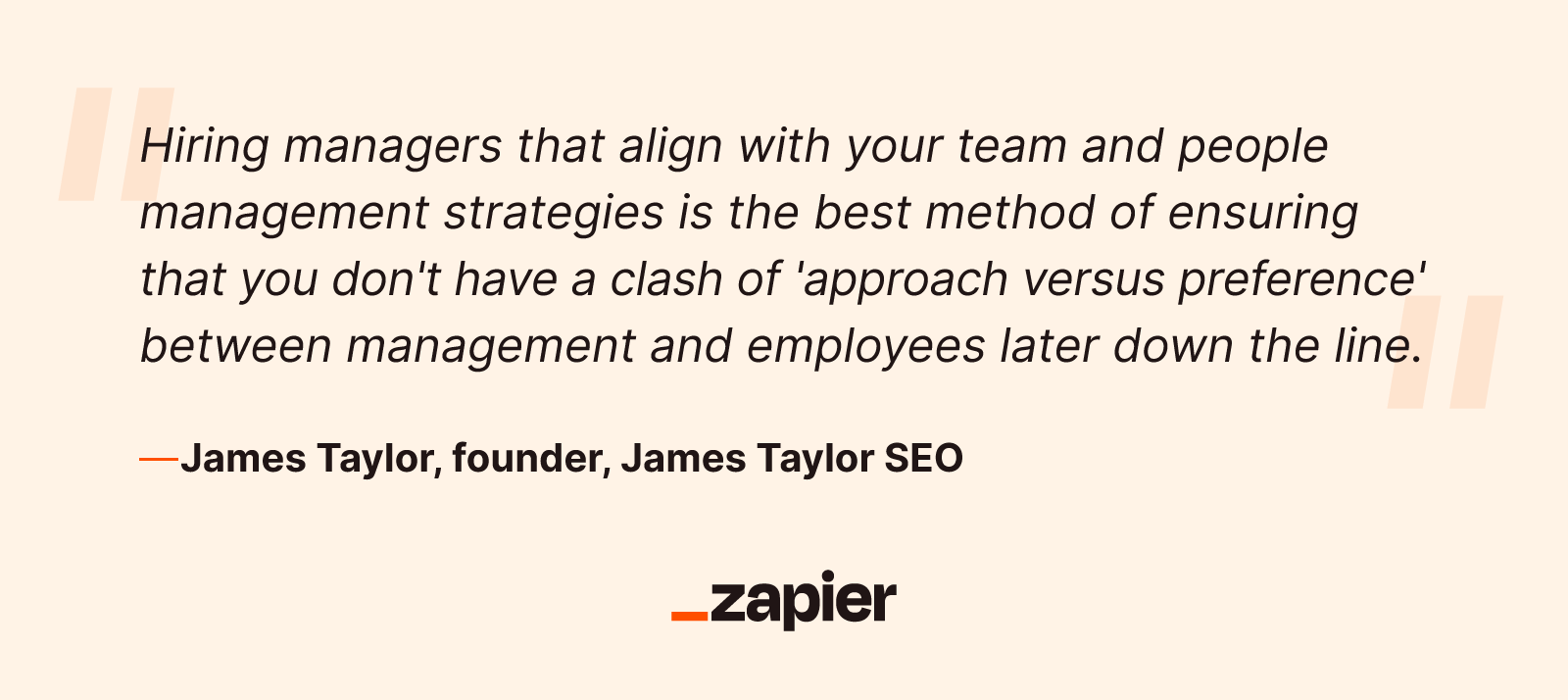Is there any bigger workplace cliché than a bad boss? I'm probably in the fortunate minority of adults who've just had one job where it was a problem. And it wasn't as much that this boss was terrible—it's more that their brand of management didn't match well with the way I like to work.
Beyond being a cliché, a bad boss is a problem for everyone involved. Not only does it stunt productivity—it's also one of the biggest reasons people quit their jobs.
While individual managers all bring their own distinctive personalities and approaches to their roles, they can often fit into some well-established archetypes. Here are 11 common management styles and how to get the most out of them.
Table of contents:
What is a management style?

A management style influences how a manager leads and interacts with their team. Are they empathetic or detached? Hands-on or hands-off? Flexible or by-the-book? The way a manager chooses to lead their team can impact how they:
Hire
Cultivate talent
Delegate (or don't)
Promote morale (or erode it)
Manage their own time
A manager's personality can predetermine their approach to leadership, making it hard for them to change. Ideally, they'll be adaptable to their teams and the existing environment without losing sight of their own unique attributes and how they can be used to everyone's advantage.
"I think the biggest thing I've learned is that it's important to be yourself. If you try to be something you're not, your employees will feel it. But if you're true to who you are as a manager, and if you stay honest about what you want from your employees, then everyone ends up better off."
—Gauri Manglik, CEO and co-founder, Instrumentl
So while managers can absolutely adapt their leadership styles in management based on their company, their team, and their role, there are certain aspects of management style that are deeply personal. That's important to remember when navigating manager-employee relationships.
Turns out humans are complex and dynamic, each with their own soft skills, so managers won't always fit perfectly into prescribed management styles. Still, considering different management types can help us learn to work better together.

1. Micromanagement management style
Strengths: Consistent communication, aligned expectations, effective guidance and training
Challenges: Difficult to maintain at scale, struggles to focus on the bigger picture, stifles trust and autonomy in subordinates
Micromanagement is always the first management style that comes to mind for me. Whether that's because it's a popular trope or because I still get flashbacks to having to log everything I did in a spreadsheet for one of my jobs as a college student and answer for any downtime may remain a mystery.
"... the micromanager is more focused on the task [than the person]."
—Krittin Kalra, founder, Writecream
While the term can get a bad rap for bothering team members, being a little too short-sighted, or stretching themselves too thin, this approach can be beneficial in certain situations. Less experienced or less focused subordinates might benefit from a micromanager's close attention and input while they learn the ropes. These types of managers should just be conscious of not stunting their subordinates' autonomy as they grow.
Tips for applying this management style:
Start small with delegation. Micromanaging usually stems from a lack of trust. By delegating small projects (and then not micromanaging them), you can build trust and start to feel more comfortable taking a step back.
Focus on outcomes, not tasks. Unless there's a problem with an employee's output, added oversight usually does more harm than good.
Communicate the why when offering guidance. If you feel the need to micromanage because your team isn't aligned, try giving big-picture feedback to see if that makes the smaller tasks fall into place.
Tips for working with this management style:
Steer the conversation toward impact, not tasks. If you're able to bring proof of your work's impact, your manager might be able to see that your methods are working and you don't need such detailed oversight.
Ask the micromanager to outline their priorities. You can't live up to their expectations if there's uncertainty. With a list of their priorities, you can always refer back to it when asking them for space to do your work.
Keep track of any blockers. If something keeps you from meeting your manager's expectations, like insufficient support, track and communicate that. If your manager is the blocker, it might be time to communicate that to your HR team.
Read more: Why employers should embrace quiet quitting
2. Laissez-faire management style
Strengths: Fosters independence, maintains time for personal tasks and goals, promotes flexibility and creativity
Challenges: Can leave employees feeling adrift, may not offer enough early guidance, can leave long-term goals misaligned
While micromanagers can be too hands-on, the opposite approach can have its own problems. Laissez-faire managers are much more hands-off with their teams and don't interfere much in daily tasks and short-term goals. These managers don't need a play-by-play and aren't assertive with instruction. While this may sound like a lack of leadership (and shouldn't be confused with ineptness or apathy), it's actually an abundance of trust. Creative employees with personal drive and independent thinking tend to work well with these managers.
"[Laissez-faire leadership] style should be used selectively, based on the industry and level of accomplishment of the employees. There is minimal structure within the organization and employees can work independently and make executive decisions. The downside is the lack of direction or intervention, so new-to-industry employees would not be candidates for this style. Management can be seen as weak or uninterested because of the lack of direction provided."
—Professor Donna Lubrano, Virtual Exchange Officer, United Planet
In the worst cases, laissez-faire managers can leave employees feeling abandoned, confused, or disconnected from their company and its goals. They also run the risk of making employees feel undervalued or unseen. Less experienced employees may even find they don't get enough instruction or training from these managers, but ultimately—like a Montessori school—it can lead to nurturing highly capable, autonomous employees.
Tips for applying this management style:
Ask employees what they need to feel supported. It's not always check-ins that people want—sometimes, it's just a general sense of direction. Each employee will thrive with a different level of support, and the best way to know is to ask.
Be honest about your knowledge. Managers shouldn't be expected to know everything. If you aren't sure of something, let employees know that you don't know but are willing to look for an answer. And don't let your impostor syndrome affect your direct reports' experiences.
Let employees know you're there. If managers seem too distant, employees may not feel comfortable reaching out. Ensure your teams know how to reach you and that you're available.
Tips for working with this management style:
Ask questions. Asking a lot of questions can indicate to your manager that you don't have all the information or guidance you need. Just be sure you're asking empathetically and focusing your questions on important topics.
Let your manager know what you need. Your manager may think they're doing you a favor by being hands-off, especially if they're trying hard not to micromanage. Start by letting them know you need more support—they might be ready to offer it.
Make it your responsibility to stay on task or ask for more time. If your manager doesn't set definite short-term milestones, you may need to set your own to stay on task through methods like lists or Kanban boards.
3. Democratic management style
Strengths: Collaboration, employee trust, equitable work environment
Challenges: Indecisiveness, slower decision-making, value judgments on team member ideas
Democratic managers treat their employees like their constituents—it's the manager's job to make decisions based on their direct reports' input. Despite their collaborative, open approach to leadership, these managers still run the show—they just confer with their teams before making their decisions. Since lower-level employees feel heard and the manager still calls the shots, it can sound categorically like a win-win for the leaders and their team. But this approach also has its challenges.
"At work, I strive for a democratic management style. I really try to empower my employees to make decisions and have an impact on their own work environment. This way, you encourage the exchange of ideas and allow for feedback to be given openly so that problems can be identified and addressed early. But I found it can be really ineffective if done wrong…. You need to trust that your employees are there to help you progress with your company. But over time, you learn that the final decision is up to you, so you become better at sifting what's useful."
—Sully Tyler, entrepreneur
Employees want to be heard and have their opinions valued—and any successful company will trust its employees to have the company's best interests at heart. But these managers still have to synthesize everyone's opinions, cut through the chatter to find the best ideas, and make plans that still may not make everyone happy. They can't be people-pleasers to a fault, and they have to be decisive.
Ultimately, it's up to managers to take the inputs and propose a strategic solution to any given problem. Remember, we're talking democracy, not anarchy.
Tips for applying this management style:
Always ask for employee input. Don't make decisions in a silo before consulting with your team. At the very least, use your direct reports as a sounding board; but try to take it a step further and use their expertise to move the company forward.
Be decisive. Employees will look to you for answers, so you have to be ready to make tough decisions, sometimes even being a tiebreaker. Make sure you're always able to communicate why you made the decision you did.
Create a problem-solving environment. When everyone's ideas are on the table, feelings can get hurt. Focus on problem-solving with the goal of working together toward outcomes rather than taking credit for an idea.
Tips for working with this management style:
Know your strengths. By honing your strengths, you'll be able to offer unique value. Aim to be a well-rounded worker, but lean on your team to make up for gaps in your expertise.
Don't take rejection personally. Since everyone's ideas are considered in this environment, yours might get outvoted or even just ignored. When faced with rejection, remember, it's not about you.
Return the trust. Your manager trusts you and your team enough to use your expertise and ideas to set and execute on strategy. Return the favor by trusting your manager when they have to make tough decisions.
4. Autocratic management style
Strengths: Organization, clear expectations, maintaining goal progress
Challenges: Identifying their own mistakes, reckoning with personal weaknesses, maintaining positive morale
Folks with an autocratic management style take a "my way or the highway" approach. They don't consult their team before making decisions, which might mean moving faster but doesn't always lead to the best results. This usually isn't the most crowd-pleasing management style, but that doesn't mean it's a bad fit for every scenario. In either case, it definitely risks promoting some hard feelings and low morale.
"... autocratic or laissez-faire leadership may create a sense of hostility amongst colleagues due to their power-dominated approach or lackadaisical attitude towards decision-making respectively. Managers should understand the importance of providing autonomy while guiding subordinates in realizing their full potential through cooperation rather than control."
—Vaibhav Kakkar, CEO, Digital Web Solutions
One hallmark of an autocratic work environment is clearly defined structure and processes. For the manager, this ensures everyone is operating as expected while providing employees with structure and clear expectations. Employees who don't operate with much creativity or who are still gaining their footing in an industry may appreciate this kind of consistency and direction.
While these managers may be slow to see the error of their ways (or may never recognize them), they tend to be adept at maintaining complex or compliance-rich protocols, and they can be great resources for establishing order in a disorganized environment.
Tips for applying this management style:
Make sure your employees feel appreciated. If employees don't have any say in the strategic side of their work, they'll feel undervalued and keep their eye on the door.
Explain why you make decisions. It's ok to make decisions for your team, but always explain your reasoning to get everyone on board.
Listen to new perspectives. It's no secret that two brains are better than one—and a team full of brains is even better. Inviting others to share their ideas can offer diverse perspectives that will help you fill gaps in your knowledge or even just surface things you completely blanked on.
Tips for working with this management style:
Collaborate with your peers. If you can approach your manager with ideas and suggestions from a group, it's harder for them to ignore. Just be careful not to make it feel like you're ganging up on them—that could have the opposite effect.
Ask why. If you can learn more about the decisions your autocratic manager is making, you'll better understand how to frame your ideas and suggestions in a way that aligns with their intentions.
Prove the value of proposals. If you find something you and your team believe should be changed but know your manager may not be receptive to your ideas, build a case for it with clear proof of value they can't ignore.
5. Visionary management style
Strengths: Inspirational, big picture-oriented, effective delegation skills
Challenges: Managing internal competition, creating a supporting team, getting buy-in for ideas others may not agree with
A visionary manager has clear, strong ideas about the future and inspires their team members with an infectious enthusiasm for their goals. With so many celebrity CEOs and business leaders out there, it's easy to romanticize this type of manager as a larger-than-life personality, but in reality, they can exist and lead effectively even in small businesses.
"Visionary management style takes a 'vision-led focus' where the long-term future is at the heart of everything. This 'eye on the prize' approach is good if you have the runway/capital for long-term plans. But if you’re in a competitive industry with finite investment, visionary management will quickly be replaced with accounting departments and a rigid shift towards everyone hitting specific metrics."
—Nirav Sheth, CEO and founder, Anatta
The key to visionary management is grounding vision in reality. These aren't just dreamers with their heads in the clouds—they've also got the savvy, creativity, people skills, and dedication to see their goals through. Visionary leaders see the big picture and also know how to put the right people around them and delegate tasks so they're free to focus on it.
Employees need to be able to see this vision and their role in actualizing it. They also have to be willing to take risks and know that their role—no matter how small—is necessary. They should also be able to keep their own egos in check since their manager may be the one who gets most of the glory when the team succeeds.
Tips for applying this management style:
Don't be afraid of failure. Visionaries are often trailblazers, and failure is always a risk. You need to be confident enough in your goals that you can overcome any fear of failure.
Creating the right team dynamic is vital. The rest of the team's job is to support the manager's vision, so you need to be clear on your roles and value. While you may be ideas-oriented, you should also be an action-oriented team player.
Be clear about expectations. No matter how lofty a goal is, it still has to be achievable. A good way to prove the viability of a vision is to be clear about what it'll take to reach it and realistic about how long it could take, what it could cost, and what its risks are. This establishes trust and confidence in your ability to execute.
Tips for working with this management style:
Know your role. Visionary leaders tend to rely heavily on their teams to execute their roles reliably. That means they'll expect you to deliver, but it also means that what you do is essential for helping everyone reach the manager's goals.
Trust the vision. If you don't have faith in the vision, then you won't have faith in the manager. If any element of that trust is out of whack, it could have a domino effect on the rest of the team. And if you really don't believe in the vision, it could be a red flag that you should consider moving to another company.
If you disagree, be able to back it up. Visionary leaders have a reputation for being strong-willed, but that doesn't necessarily mean they're inflexible. At the end of the day, they want to realize their goals, so if you see a better way to do something and can prove it'll help reach that end, they'll be more likely to listen.
6. Paternalistic management style
Strengths: Team morale, employee retention, open communication
Challenges: Making decisions that negatively affect team members, losing focus on business goals, maintaining growth goals
Not to be confused with the typical use of "paternalistic"—which can have a negative connotation—paternalistic managers apply a sense of empathy and focus on employees as much as (or more than) they focus on strategy and execution. That means understanding that direct reports are more than just employees—they're people whose emotions, traits, preferences, and outside-the-office lives are just as valid as their roles in the office.
These managers work to cultivate a familial dynamic that helps teams feel supported and like part of a community. The key to this archetype is a strong leader who creates a comfortable and people-first work environment.
"Leaders with [paternalistic] management style can create a very comfortable familial environment where everyone feels they are part of something larger, and all staff feels supported and cared for. However, it's easy for paternalistic leaders to also be controlling or somewhat ineffective when it comes to disciplining staff. I think this leadership style is best adapted a little to the specific employees on a team."
—Carter Seuthe, CEO, Credit Summit
Leaders with so-called paternalistic styles of management are equitable—they're not partial to one employee or another. These managers have a bit of crossover with democratic ones, as they listen to their teams and value everyone's voices regardless of their role.
Additionally, they try to make decisions that will benefit everyone. They believe employees aren't just a means to a corporate end—they're the business's essential lifeblood. These benefits can also make it harder for these managers to make tough decisions that negatively impact their teams, and in the worst cases, can lead them to make choices at the expense of their business goals.
Tips for applying this management style:
Manage the human, not the worker. Address long-term negative patterns while leaving wiggle room when life gets hard for employees.
Help employees see their potential. Build their confidence and guide them toward growth. And don't forget to celebrate wins!
Reflect with your employees. Take time (with your direct reports) to assess what's working and what's not within their role and their work.
Tips for working with this management style:
Don't take advantage of empathy. Life gets in the way sometimes, but if you start to take advantage of your manager's flexibility, it can lead to resentment.
Think about your own growth. Ask your manager how to grow your skills in areas they have more experience in.
Be realistic. While the communal feeling in these teams is comforting, it can also lead to feeling blindsided if attrition, demotions, pressure from upper management, or other negative experiences arise.
7. Transformational management style
Strengths: Team member autonomy, teamwide sense of purpose, innovation
Challenges: Team member retention, working with less independent team members, maintaining short-term goals
A transformational manager focuses on improving both their employees and their business by fostering an environment of growth, self-improvement, and innovation. This type of manager can adapt to change—change in an industry, change in a company, and change in a team dynamic. They're big-picture thinkers who have a strong handle on the ways systems, roles, and structure influence long-term success and are very good at visualizing the future.
"Agile and growth-oriented are characteristics of transformational management style. Managers concentrate their efforts on encouraging their people to continually push outside their comfort zones and increase the bar for success while also inspiring them to do so. Managers collaborate with their staff, motivating them to put in the ever-increasing effort by exemplifying a strong work ethic themselves. Employees are more creative and can adjust to change, interruptions, and difficult tasks more readily."
—Ovidiu Cical, CEO and co-founder, Cyscale
A transformational manager prioritizes their individual team members and pushes them to grow together. They aim to cultivate talent and support professional growth opportunities, promote creativity, and devise structural changes as needed. If something isn't working, they scrap it and replace it with a new system, pattern, or process that does.
Because they prioritize self-improvement, their team members tend to grow and advance quickly. While this can be great for morale, productivity, and short-term retention, it can also lead to turnover as their direct reports hit advancement ceilings, get head-hunted by competitors, or move into management positions in other companies.
Tips for applying this management style:
Protect your employees from change fatigue. While you need to be transparent with your team, it's also good to prevent whiplash—before you share sweeping changes, make sure they're set in stone and that you have the context you need to explain them.
Track progress. Focusing on data can help you be sure you're flexible with your strategies and don't stick to one route simply because it's the path of least resistance.
Check in with yourself. Managers of this type can burn out or lose focus, so understand your limits, and check in with yourself to make sure you're not over-exerting or thinking too much about the big picture too much of the time.
Tips for working with this management style:
Suggest improvements. Watch for trends and patterns, and flag them for your manager if you think there might be a better way of doing something.
Take initiative to grow. These managers appreciate initiative and value skill cultivation, so learn as much as you can and hone your skills with their direction.
Be flexible. Things will change at work, and you need to be willing to roll with the punches. If you're feeling overwhelmed with back-and-forth changes, let your manager know that it's causing some whiplash.
8. Coaching management style
Strengths: Team rapport, long-term growth, mentorship, constructive criticism
Challenges: Retention, personal productivity, short-term goals
A manager with a coaching style puts a high premium on employee development. This can be similar to transformational leadership, which also aims to grow a team's skills, but coaching managers take a more hands-on approach by adopting a mentor role with their direct reports. They tend to be empathetic, personable, and excellent communicators, which promotes loyalty and boosts morale.
"Our teams usually follow a coaching management style. This revolves around directing, coaching, delegating, and supporting. This strategy helps in developing both personal and professional leadership skills. A coaching leader supports and challenges team members simultaneously…. The primary intent is to focus on their development goals in the long term."
—Erin LaCkore, founder, LaCkore Couture
One obvious flip side of this management style is that it takes up a lot of time and energy that other types of managers can devote to their work or advancement. This can also make it tough for them to meet short-term goals since their teams might have bigger learning curves or may not be able to work as efficiently as others. And, like transformational managers, as their team members grow their skills and experience, they might be more apt to challenge themselves to move on to other companies.
Tips for applying this management style:
Be patient with short-term failure. As employees grow, they'll make their share of mistakes. But it should be well worth it once they become more capable and independent.
Build mistakes into timelines. If you know some people might need a little more coaching than others, make their timelines a little more generous to give them a buffer.
Take time for yourself. When you prioritize everyone else's growth, it's easy to kick your own opportunities to the curb. Keep cultivating your own skills and looking for ways to be coached yourself.
Tips for working with this management style:
Pick their brain. These managers are great resources for personal growth, so don't miss the opportunity to grow skills and experiences that could help you in this role and beyond.
Understand that it'll be a process. Working with coaching managers tends to be a long-term process. You'll make mistakes along the way, but it'll help you become more efficient and independent.
Try things out and apply creativity. Don't be afraid to make mistakes. These managers are typically empathetic and committed to the learning process, so this is a great opportunity to flex your creativity and get constructive feedback.
9. Persuasive management style
Strengths: Clear direction, decisiveness, reason
Challenges: Promoting creativity, promoting morale, flexibility
Persuasive managers have clear visions, steadfast beliefs, and the conviction to get others on board with their plans. They're similar to visionary leaders in these ways but have a more hands-on role.
Like autocratic managers, they make decisions unilaterally but are much more apt to back up their decisions with proof or reason to convince their teams to go along with their choices. This usually isn't hard because a persuasive manager is usually a consummate professional who naturally inspires respect for their expertise.
"Persuasive management is when a leader persuades and influences their team to get the results they want. It works well when the team is not motivated or doesn't know what to do, but it can also cause problems if team members don't feel included or invested in the process."
—Matthew Ramirez, founder, Rephrasely
Persuasive management can seem a little negative, and there are certainly persuasive managers who take a more coercive approach to get what they want. But at their best, these managers are decisive, facts-driven, and generally well-intentioned. They've crunched the numbers and see the way forward—they just work to get others to buy in. Their teams know what to expect of them, they know their goals, and they know why things are done the way they're done.
Tips for applying this management style:
Practice flexibility. Even if you're extremely experienced in your field, new ideas can come from anywhere, and it can be too easy to dismiss them.
Make space for other people's expertise. Persuasive leaders get where they are because they're very good at what they do, but they may be more limited than they think. Bringing in team members with expertise in arenas where you lack experience can help keep perspectives fresh and make the environment more dynamic.
Know others may not be convincible. When no amount of proof or reasoning can get others to see your vision, remember that can be ok, too. There may be room for compromise or opportunities to motivate them so they don't get hung up on feeling like they aren't being heard.
Tips for working with this management style:
Trust their vision—if they're able to show why you should. Since this management style tends to come with experience, expect these managers to see things you may not. That doesn't mean you should trust them blindly—they should still be able to communicate their reasoning clearly and convincingly.
Expect accountability. Persuasive managers are the ones making the final decisions and making their cases for them. That means they'll also take responsibility for when things don't work out as planned.
Examine their intentions. No one wants to be taken advantage of. While these managers can be hyper-focused on business goals, I'd be lying if I said none of them ever let their egos get the best of them. Their decisions should always be in service to collective goals first.
10. Bureaucratic management style
Strengths: Straightforward procedures, clear expectations, careful documentation
Challenges: Lots of paperwork, inefficiency, red tape
You can sum up the bureaucratic management style with one word: procedure. Bureaucratic managers prioritize clear standards, structure, and meticulous documentation. If your company has a multi-page form for every single process, you may be working under this management style.
"Bureaucratic leadership is particularly effective in strictly regulated environments or in situations where safety and precision are paramount. It provides clear-cut guidelines and prevents ambiguity."
—Gianluca Ferruggia, General Manager, DesignRush
Bureaucratic managers might not deliver rousing speeches or inspiring appeals, but this doesn't make them bad leaders. Instead, a good leader can use bureaucratic management practices to keep large workforces organized, ensure compliance across teams, and maintain a high level of accuracy and accountability in high-stakes industries like healthcare or defense.
But this isn't always the most efficient style. Rigorous adherence to procedure can lead to inflexibility and red tape, slowing down workflows and stifling creativity. Good bureaucratic managers won't bog their employees down with excessive paperwork, but it's a definite risk.
Tips for applying this management style:
When possible, allow for nuance. Not every employee works the same way, even with clearly set standards. Being open to some degree of variation can keep your workplace from becoming too rigid.
Listen to employee concerns. A company may have clear, established guidelines, but this doesn't mean those guidelines never change. If employees vocalize a desire for change, let them know they're heard—and actually hear them.
Watch out for paperwork pileups. Paperwork has its place, but too much of it can keep employees from doing actual work.
Tips for working with this management style:
Trust the process. Bureaucracies are all about the process. Do your best to accept that, broadly, strict procedures are probably in place for a good reason.
Know the hierarchy. Bureaucratic managers use clear hierarchies to streamline communication. You'll want to follow the chain of command closely under this style. In other words, know who you report to and who reports to you (and don't go over anyone's head).
Take advantage of the consistency. While you probably won't be convincing these managers to do company-wide shakeups, it can be comforting to know that things will pretty much always work the same way in a bureaucratic workplace. Use this stability to your advantage.
11. Servant leadership management style
Strengths: Employee-centric, good for team bonding, puts health and wellness first
Challenges: Unclear hierarchical structure, not goal-oriented, doesn't suit every kind of business
The servant leadership management style entails exactly what its oxymoronic name suggests—leaders serving. Coined by Robert K. Greenleaf in 1970, the term "servant leadership" describes an approach to management that prioritizes employees' needs, well-being, and happiness.
"Servant leadership is akin to a nurturing gardener, promoting the growth and development of individuals. It's particularly effective in corporate cultures where people are the greatest asset. What sets it apart is its empathetic approach—leadership that listens and understands."
—Laia Quintana, Head of Marketing and Sales, TeamUp
This style breaks with traditional workplace hierarchies. Instead of telling their employees what to do, servant leaders ask their employees what to do. In one-on-one meetings, they favor conversations over performance reviews.
You can think of it as the polar opposite of the autocratic management style, but that doesn't mean it's hands-off. Servant leaders are intimately involved in making employees feel seen, heard, and appreciated—and this takes work.
Servant leadership can lead to great team relationships, but it lacks the clarity and structure of more hierarchical approaches. Employees used to autocratic or coaching managers may struggle without clear direction, feedback, and criticism. Efficiency might take a hit, too, if company goals aren't priority number one.
Tips for applying this management style:
Strike a balance. Putting employees first is a noble goal, but it shouldn't lead to a total breakdown in structure or efficiency. By finding a balance between serving and leading, you can keep employees happy while still meeting company goals.
Know your people. Servant leaders are uniquely positioned to forge strong bonds with their teams. The best way to do this is to know your people like the back of your hand—and that means more than their names and job titles.
Step up when needed. Be prepared for situations where clear instructions and feedback are necessary to meet business objectives. Sometimes, you may need to lean into the leadership side of servant leadership to get things done.
Tips for working with this management style:
Express yourself. The only way your manager can put your needs first is if they know your needs. This style thrives when employees communicate clearly with managers about their personal goals, preferences, and circumstances.
Validate their efforts. Servant leaders frequently put their employees' needs before their own. Tell them you recognize and appreciate what they're doing, so they know their efforts aren't going unnoticed.
Take initiative. Working with these managers gives you a high level of autonomy. Make the most of it by taking charge of projects and developing leadership skills of your own.
What to do about negative management styles
Let's face it—not every manager is a people person. Some of these styles above lend themselves more to good workplace energy than others, to say nothing of managers who let their ego do all the talking or who are outright malicious.
"This is the manager who is kind, encouraging, and supportive to your face, then betrays you by blaming you in front of their boss or gaslighting you about promises they claim to have never made. This is the worst kind of manager because it chips away at your self-confidence and sense of professional expertise. It can also call your competence into question because it is your manager's word against yours."
—Gates Little, CEO, altLINE Sobanco
If you have a negative manager like this, it's either because they weren't prepared to become a leader or are more committed to protecting or promoting themselves.
If the former is true, then they need more experience; if the latter is true, it's likely stemming from a personality trait that won't change. If you experience either, it may be time to start figuring out how to remove yourself from the situation.
Tips for handling a negative management style:
Communicate. It's possible that your manager just doesn't have a leadership style that naturally matches the way you work. If that's the case, that doesn't necessarily make them bad managers. Let them know your needs, and see if you can come up with a resolution.
Do your work in public. As much as possible, communicate with your manager in public channels (e.g., group calls, public Slack channels, group emails) to document everything. Even if you don't think you plan on bringing any of it up, it's worthwhile to have a record.
Check HR protocols. If you feel personally attacked or targeted by your manager, it's worth looking into your HR protocols or talking with an HR manager. No workplace environment is worth sacrificing your physical or mental well-being.
Using different management styles

Your team, work, and perspective are constantly changing—and that means your management style (or your manager's style) might change too. In fact, adapting your management style to each person on your team can be a huge strength.
In the end, there's no best style of management. As an organization, you can set yourself up for success by hiring employees and joining companies that align with your values.
No two people are the perfect manager-and-employee match—but by being flexible and understanding the humans behind the roles, you can be sure that different types of management styles don't break an organization.
Management styles FAQ
Management is an art—if it wasn't, we wouldn't have bad bosses—and there's always more to learn. Here are some answers to a few final common questions.
Which management styles make effective leaders?
It isn't so much the management style that makes an effective leader—it's how that style is implemented. While certain styles (like micromanagement) have negative connotations—and are usually implemented poorly—strong leaders who understand their employees' and business's needs can still use them effectively in some contexts.
What is the best management style for handling conflict?
While no management style is guaranteed to help resolve conflict, some are likely to work better than others. (Good luck micromanaging your way out of Dave eating Sharon's lunch.)
Styles that emphasize team morale and cohesion—like paternalistic management, coaching, and servant leadership—may help reduce the likelihood and severity of conflict. On the other hand, autocratic managers can quickly resolve conflict with unilateral decisions, though they might not leave everyone happy.
What is the difference between leadership styles and management styles?
You can think of management styles as leadership styles applied to the workplace. Any management style can also be a leadership style, but not all managers are good leaders.
Related reading:
This article was originally published by Steph Knapp in December 2022. The most recent update, with contributions from Dylan Reber, was in May 2024.









